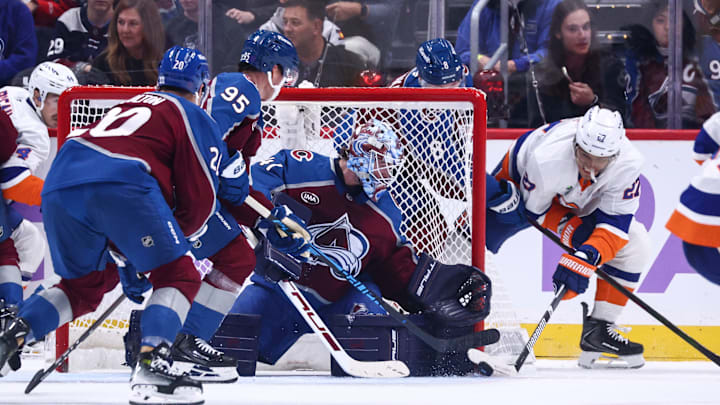The Colorado Avalanche are setting the pace in the National Hockey League this season. They continue to reign atop the leaderboard in points, with 31, and haven't lost since November 1st. At 13-1-5, the club is officially a problem for the rest of the hockey world to try and solve.
If it feels as though I am running out of ways to say this team is good, that's only because they excel almost everywhere. Currently, Colorado is tied for the most wins with several teams. Their lone regulation loss, and 5 OTLs, help account for their advantage in the standings.
Most hockey fans expect the Avalanche to be an offensive juggernaut. With 78 goals scored this season, the Avalanche have lit the lamp eight more times than the next closest competitor, the Toronto Maple Leafs.
Where the team has taken virtually everyone by surprise is their superlative play in net. Backup goalie Scott Wedgewood has preformed like an All-Star under pressure. After being pressed into starting duty because of injury to Mackenzie Blackwood, Wedgewood has been dynamite. The incredible start even earned him an extra year presumably chasing Stanley Cups with Colorado.
Wedgewood has already won 11 contests for the Avalanche this year, and boasts a sterling .917 save percentage. Thanks to the 'Wedgewall', Colorado has allowed only 45 goals officially. Google may say 47 due to a pair of shootout losses.
Obviously, you don't have to be a sports guru or a math genius to see why scoring the most goals and allowing the least is a good sign. The Avalanche’s goal differential is, however, perhaps the greatest indicator of overall dominance.
Colorado has scored 33 more goals than they have allowed in 2025-26. The next closest is the Carolina Hurricanes with a differential of +16. That means that the Avalanche have more than doubled the statistical second-best.
Almost 20 games into the campaign, this feels more significant with every passing day. Even I was taken aback at this realization, but it did prompt me to want to take a look at Colorado Avalanche history.
Championship differential?
Keeping this pace is surely going to be difficult, and it's nothing an organization could really pursue in earnest. But I did find a little dip back into the glory days interesting.
In the 1995-96 season, Colorado scored 326 goals and gave up 240, for a positive differential of 86. That year, they finished second in the category to Detroit. In 2000-01, the Avalanche again finished second in the stat, with a positive differential of 78. The New Jersey Devils had the best goal gap, but famously fell short to Colorado in an epic Stanley Cup Final.
Now, before you start thinking second place is the sweet spot for raising Lord Stanley and a potential fourth banner, consider 2021-22. In Colorado's most recent triumph, they finished all the way down in fourth place in the category, behind Florida, Calgary and Carolina. That year, the Avalanche scored 308 goals and allowed 232 for a positive differential of 78.
What all this says to me is that goal differential is a great measure of gauging contender status, but not predicative of ultimate success. That is unless the Avalanche can maintain their lead in both goals scored and fewest goals allowed all year long.
One of the only examples of that occurring in NHL history is of the 1976-77 Montreal Canadians, who absolutely blistered their opponents and still hold the all-time record for goal differential as a result. Those champion Habs scored 387 goals and allowed just 171, for an almost unbelievable differential of a positive 216!
There are no guarantees, but...
So maybe no single stat, other than the final score in a Stanley Cup Finals close-out game, will be the stat. Looking for that smoking puck proof of greatness in the middle of November is a touch early. Regardless, I do think it will be a worthwhile metric to track for the Avalanche going forward.
Buried in the details of what it takes to pace the entire league in perhaps the most crucial offensive and defensive numbers are a whole host of advantages it can afford a team with championship expectations.
To put it another way, yeah a 9-1 blowout goes a long way in padding the margins. But even less impressive outings by the Avalanche look decisive on the scoreboard because teammates lift each other up.
Consider the last two wins for a moment: A 6-3 victory over Buffalo last Thursday and a 4-1 win over the Islanders on Sunday. The first was frankly a clunky day for Mackenzie Blackwood, who was likely unhappy with at least two of the goals he let in. Yet, the offense came up clutch when it mattered and they came out on top going away. On Sunday, the offense looked slow and out-of-step for at least half the game, but Wedgewood totally locked it down in net after an early fluky one beat him.
This kind of all-around team effort is always going to be fun to witness. I would also say that even if the pace falters somewhat, as lulls are inevitable, it bodes well for sustainable success as a collective unit. After all, who wouldn't want to be playing like the Colorado Avalanche?
